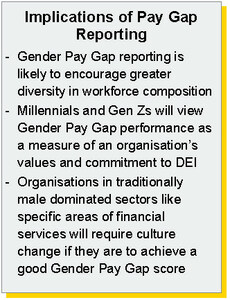
Marie Claire Bennett
Gender Pay Gap reporting will shine a spotlight on organisations where there are marked inequalities around pay. Gender Gay Gap reports will also include statements of the actions organisations intend to make to bridge any gaps identified. Identification of inequality in one area will almost inevitably lead to wider change within organisations, particularly in relation to culture.
Analysis of the underlying causes of pay gaps will generate greater awareness of inequities within the organisation. These could relate to the ability of women returning from maternity leave to progress within the organisation and the speed of that progress, for example.
That increased awareness will in turn lead to a greater focus on the overall diversity, equality, and inclusion agenda and will encourage a broader and more diverse workforce composition.
Organisations in the financial services sector with poor gender pay gap scores will inevitably require culture change. That change must be driven from the very top. The CEO sets the tone and is the culture carrier in the organisation.
It will have a particular impact on the financial services sector where DEI is now garnering more attention from boards and C-suites. This is very welcome, particularly when you consider the male dominance of certain sub-sectors of financial services, insurance being one.
As things stand, the attractiveness of insurance to millennials, and female millennials in particular, likely has room for improvement. That industry needs to make itself more attractive to females and other cohorts and addressing the Gender Pay Gap and embracing the DEI agenda will be a good start.
Furthermore, Generation Z members are very drawn to purpose and are attracted by purposeful leaders. This will require all financial services organisations to pay more attention to CSR and the DEI agenda. There are lots of pressure points coming to bear, it is not just the Gender Pay Gap legislation.
Influencing the employee value proposition
The employee value proposition (EVP) is made up of several different component parts including direct and indirect financial benefits, career paths, and learning and growth opportunities. Against the backdrop of Gender Pay Gap legislation and other global trends in relation to the factors that influence individuals’ choice of employer, organisations will have to pay much greater attention to their EVP and its components.
It is likely that Gender Pay Gap performance will become an increasingly important part of the EVP mix. It will become a barometer for the organisation’s commitment to fairness and equality of opportunity and will become a key factor in its ability to attract, manage and retain talent. Other factors such as purpose and values and the culture of the organisation are also growing in importance. We are seeing leaders switching gears and upping their game to address this new reality. It’s a really good time to be entering the workforce.
In what other areas, will a focus on GPG affect the work environment? For example, greater sensitivity to the development of an inclusive physical environment or the development of neuro-diverse facilities to attract new cohorts of talent.
Gender Pay Gap legislation and greater awareness of DEI issues are presenting organisations with the opportunity to engage, collaborate, learn, and innovate in a hybrid world. They are exploring how to set up the physical work environment in ways that support collaboration and innovation and enable people of all abilities to be their best selves and do their best work.

As we welcome more groups such as neurodiverse individuals into the workforce, we have to consider all aspects of the physical environment, be that noise levels, lighting, or the number of seats per square foot. EY has established a network of neurodiverse centres of excellence in various locations around the world, including Canada, India, Poland, Spain, the UK and the US. These centres of excellence are designed to create a supportive working environment for people with cognitive differences – such as autism, dyslexia and ADHD – that will help them to apply their strengths and meet clients’ business needs in emerging technologies like artificial intelligence, data analytics, automation, blockchain and cyber.
That is just one example of how greater diversity can make a positive contribution to organisations. There are many others and Gender Pay Gap reporting is helping to generate greater awareness of these benefits.
Changing corporate culture in the financial services sector
Ultimately, a good gender pay gap score is a reflection of a healthy corporate culture. Organisations in the financial services sector with poor gender pay gap scores will inevitably require culture change. That change must be driven from the very top. The CEO sets the tone and is the culture carrier in the organisation.
Everything within the organisation must be aligned with its cultural vision. And that vision should include a strong commitment to the DEI agenda. Behaviours and practices which are aligned to that vision should be recognised and rewarded and DEI should become a component of the employee performance scorecard. DEI training should also be mandatory for all employees. That is already the case for many financial services organisations and professional services firms like EY.
Societal impact is also very important. Organisations should aspire to a culture which seeks to have positive impacts on employees, customers, suppliers, communities, and society in general. Gender Pay Gap reporting can only help in achieving that goal.
Gender Pay Gap reporting may be quite narrowly focused on one aspect of the DEI agenda, but its cultural implications will be far wider. Organisations which do well on Gender Pay Gap performance will likely have a superior employee value proposition to those which don’t score so well and will therefore be at an advantage when it comes to attracting and retaining talent. In addition, the increased consciousness of inequalities within the workplace can only have a positive impact on organisations’ commitment to the DEI agenda and will almost certainly lead to a more diverse workforce overall.
